Rupert Matthews's Blog, page 3
January 25, 2021
St Valentine - updated for the Days of Covid
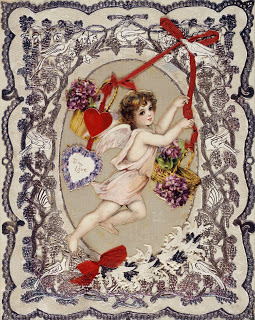
Every year in early February, I give my talk "St Valentine - from Martyr to Lover" to a number of groups. It tends to go down well and is filled with all sorts of historical snippets about St Valentine himself and the way his cult as patron saint of lovers has grown and changed over the centuries.
Along the way we take in the persecution of Christians in the Roman Empire, the medieval obsession with holy relics and the power of American commercialisation in the modern world. As well as chocolates, some pretty awful poetry and a Chinese cowherd.
This year, I have had to update the talk in light of the Covid Restrictions. So, while I am desperate for Boris to ease lockdown and allow us to get back to our basic human freedoms, I'm rather hoping he won't do so until after 14th February. Or I'll have to rewrite this talk all over again.
St Valentine is just one of several seasonal talks in my repertoire. I also have on offer:
The Real St Patrick [March] [Zoom Friendly]
The Real St George [April] [Zoom Friendly]
Who was Guy Fawkes? [November] [Zoom Friendly]
A History of Christmas Foods [December]
The Biography of Father Christmas [December] [Zoom Friendly]
So, if you are looking for speaker in March, April, November or December and want a cracking seasonal talk to get your audience buzzing, drop me a line on rupert@rupertmatthews.com or through Twitter or Facebook at @HistoryRupert.

FILM REVIEW - The Seventh Survivor [1941]
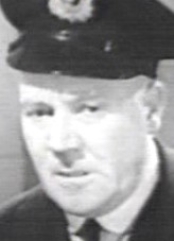
I am guessing that this was a B Movie. It runs for only 1 hour and 15 minutes and takes place mostly inside four rooms and a staircase. Nevertheless, it is worth a watch if for no other reason than the comedy turn by Wally Patch as the lighthouse keeper [pictured] kept me chuckling.
Anyway, this is a spy thriller made and set during the Second World War. It begins in the HQ of the British spy network in London. The chief spymaster gets a coded message that a top German spy is on a ship steaming from Ireland to Portugal taking with him/her [nobody knows if this spy is a man or woman] top secret plans to something or another vital to the war effort. Bad news. But good news - a crack British spy is also on board and seeking to identify the spy and get the stuff back again. We then go to the ship to meet the six passengers. A right mixed bunch they are too. All very shifty and suspicious. The ship is then torpedoed - or so we are told clearly the budget wasn't up to special effects like that - and the passengers fetch up in a lifeboat. It is foggy and the British destroyer that rescues the crew cannot find them. They are, however, found by the captain of the U-boat - now sunk by the destroyer. He is the 7th survivor, you see. The lifeboat ends up at a lighthouse, manned by the comedy actor Patch and his comic sidekick. The rest of the film is taken up by the passengers trying to work out who the spy is before the replacement U-boat arrives to take them all into captivity as prisoners of war.
Apart from Patch, I recognised a few faces from other films but I can't say that I actually knew any of them. The acting was pretty good, considering, and the script kept darting around with plenty of red herrings to keep the viewer guessing. Everyone has a dark secret to hide - conman, dodgy business deals and so forth.
The most obvious thing that struck me was the absolute absence of any music. Apart from a few seconds of tune over the opening credits, there was nothing. No incidental music and not much in the way of sound effects. It was almost as if they went to a theatre, set up a couple of cameras and filmed a stage show. The lack of exterior shots was rather offputting. Apart from the lifeboat shot - which was so tightly cropped that it could have been shot on a duckpond - we are either inside the ship or inside the lighthouse.
It helped to pass the time during covid lockdown, but unless you are a big fan of Wally Patch and his comic antics, I'm not sure I would bother. Still, it is available to view HERE if you are interested in a period piece.

January 24, 2021
FILM REVIEW - The Sheriff of Fractured Jaw [1958]
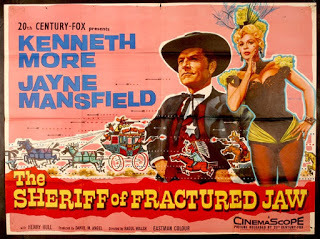
Oh dear!
The movie poster says it all really. The names and photos of the two stars - Kenneth More and Jayne Mansfield - are featured prominently. And they are just about the only good things in the movie. Though to be fair, Robert Morley is as wonderful as ever for the 5 minutes he is on screen.
The plot is not entirely unbelievable. It concerns The dilletante heir [Kenneth More] to the Tibbs Firearms factory and fortune being ordered by his aging uncle [Morley] to stop fooling about and join the company and work for a living. More is then packed off to the Wild West where guns are in great demand to sell the company's products. He arrives in the remote cattle town of Fractured Jaw and promptly stumbles into a range war being waged between two rival ranch owners - both of whom mistakenly think he works for the other. By hapless mischance More becomes the sheriff. He meets the owner of the local saloon and dance hall [Mansfield] and strikes up a friendship with her that gradually blossoms into romance. The local tribe of "injuns" then takes a hand. The whole thing culminates in a grand three-way shoot out between the warring ranchers and the tribesmen. With More marrying Mansfield and settling down to a new life in the West.
If this all seems rather unlikely for a British film, it was based on a Canadian novel and financed by 20th Century Fox - to whom Mansfield was under contract.
The main interest lies in the performances of More and Mansfield. Both of them display a neat touch for light comedy and slapstick. And some of their dialogue as they fall in love is amusing and nicely written.
But the rest of the movie is pretty dire. Stereotypes are on display in large measure and are so crude as to be embarrassing. The tribesmen - and their womenfolk - are the grossest of caricatures while the cowboys are flat and two dimensional. There is one entertaining moment when the town drunk lurches into view and is revealed to be none other than Sid James sporting an unconvincing American accent.
If you are a fan of More and/or Mansfield give it a go HERE. Otherwise, don't bother.

FILM REVIEW - The Wild Geese (1978)
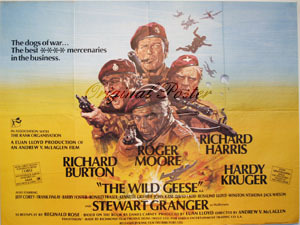
I was prompted to watch this classic action movie by a magnificent podcast by the boys at "Fighting on Film". You can listen to the podcast HERE. The podcast is not a film review as such, but is instead a fascinating look at the movie by a couple of military historians. They check the film out for the accuracy of the weapons shown and their capabilities [generally fairly accurate] as well as other hardware such as aircraft, trucks etc [not quite so] and includes some background on the production of the movie.
I vaguely remembered the movie. I think I last saw it on TV with my dad about 20 years ago or more. Anyway, the podcast prompted me to try to find the movie on line. It is HERE if you want to watch it. Quality is not so good as a DVD, but it is cheaper.
So the movie has a great cast. Not just the headline stars of Richard Burton, Richard Harris, Roger Moore and Hardy Kruger, but also a cameo role by Steward Granger at his slinkiest, sinister best. There are also a huge number of familiar faces from British cinema such as Jack Watson, Frank Finley, Ronald Fraser, Kenneth Griffith and many more. I would have said that the prodution values are pretty good. Lots of stunts, explosions, vehicle stunts and such like. Also they don't seem to have skimped on the sets and settings - most of it was shot on location in Africa or London.
The story is fairly straightforward. An enormously wealthy and equally crooked businessman [Grainger] hires a noted mercenary leader [Burton] to go to Africa to rescue from prison a highly respected former president of the fictional republic of Zembala - President Limbani [Winston Ntshona]. Ostensibly the motive is to put Limbani back in power and so resuce Zembala from the corrupt rule of dictator Ndofa. In fact Grainger wants to use Limbani as a threat to blackmail Ndofa into signing over lucrative mining rights. Burton recruits a team of British ex-military men, many of whom have a particular skill, to plan and carry out the prison break. At first all goes well, but then Ndofa signs over the mining rights. With no further need for Limbani, Grainger cancels the aircraft on its way to pick up Burton, Limbani and the team. Abandoned in the middle of Zembala with thousands of local troops closing in on them, the hapless mercenaries have to fight their way out - a process which takes up the rest of the movie.
As I said, this is a great action film which stands up well to passing of time since it was made. There is an interesting little subplot of the relationship between Kruger's racist Boer mercenary and Limbani. Similarly the storyline focussing on how a man of action [Watson's character] can struggle with a quiet home life as old age creeps up on him is nicely handled. On the whole though, this is an undemanding action film. And very entertaining it is too.

January 20, 2021
The Real King Arthur - via Zoom
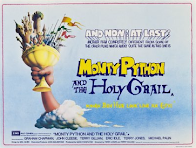

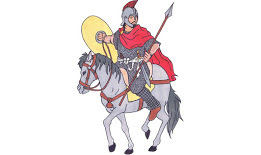
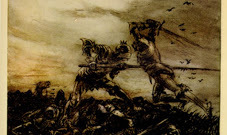
Movies, books and television series have been produced recounting the tales of Arthur, Merlin, Guinevere, Lancelot, Galahad, Ophelia and the other legendary characters. And yet the panoply of chivalric legend is known to have been added from the 12th century onwards. But behind this later accretion of legend and romance lay much older stories firmly routed in Dark Age Britain. But scholars are divided over how much truth the older stories contain. It is generally agreed that the character of Merlin is based on the bard and poet Myrddin Wyllt, who died in about 612, while Lancelot was a Breton nobleman who died around 680. Most enigmatic of all is Arthur himself who may have been a post-Roman ruler or military commander of about 500 – though some historians doubt he even existed. This talk untangles the later legends and seeks to find the truth that lurks behind them.
The audience was particularly interested in the cultural changes that overwhelmed what is now England during the Dark Ages. There were questions on the way Christianity was replaced by paganism, why people stopped talking Latin and began conversing in the Germanic precursor of English and that all led into a discussion on how people identify their own culture in opposition to others. Great stuff. I'm glad I took party.

January 18, 2021
FILM REVIEW - Windbag the Sailor
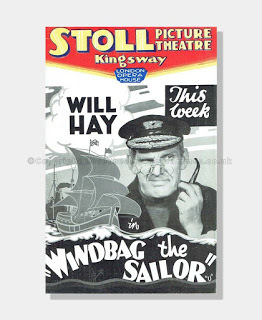
This is the first in a series of posts reveiwing films that either cover historic events or are themselves old and a part of our history.
Today: "Windbag the Sailor" a 1936 British film starring Will Hay.
As with many of Will Hay's films much of the humour comes from the fact that the man in charge, the figure of authority, is a fool.
Will Hay plays Ben Cutlet, a retired bargee on the canals. He lives in his sister's pub and pays his way by keeping the locals entertained [while they buy drinks] with wild, fantastic and completely false stories about this adventurous life on the high seas - fighting pirates in the South China Sea, being marooned on a desert island, surviving the worse storm ever seen etc etc. He is overheard - and recognised as a fraud - by the dishonest manager of a shipping line who wants to scuttle a ship for the insurance, and who needs a captain who won't notice what the mate is up to.
Captain Cutlet is thus hired and through misadventures actually goes to sea with the barman from the pub [Moore Marriott] and the pub's boy [Graham Moffatt] as stowaways. The hammock in the captain's cabin offers slapstick opportunities, while the trio's efforts at working out the ship's position bring in the sort of nonsensical wordplay that made Hay famous in Music Hall before he went into farms.
After assorted comic adventures, the villainous mate sets the trio adrift on a raft while he gets down to scuttling the ship. The raft fetches on a tropical island where the hapless trio are captured by the natives. It is here that modern audiences might balk. The natives are a curious mix of Polynesian, African and Caribbean cultural traits - and are portrayed as being utterly naive when faced with the modern world in the form of Capatian Cutlett and his radio set. Clearly the movie producer just wanted some hapless natives as a plot device and gave no thought at all to modern politically correct senisibiliites - it was 1936 after all. When the mate and crew also arrive on the island, the trio persuade the natives to throw the "bad men" into prison.
After further tomfoolery on the island and on the high seas, everyone is rescued and the trio go home as heroes. There is one last piece of slapstick on the grand scale that you can see coming a mile off - but which Captrain Cutlett can't, which I suppose is the joke.
Overall a good comedy movie. Rather slow-paced for modern tastes, as many films of this vintage are, and the modern viewer may find the island section somewhat racist. But the jokes, wordplay and slapstick kept on coming. Worth a punt if you have a spare hour and a half some time. It is on YouTube being out of copyright.

January 16, 2021
BOOK REVIEW - The Gobi Desert by MildredCable
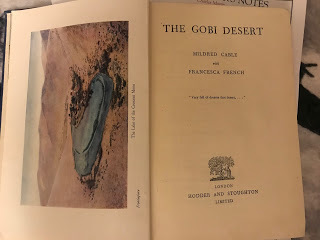
This is a fascinating book.
I got it second hand and did not realise just how well-known the author actually is. So far as I was concerned it was a cheap second hand book written at the time and so was likely to be an interesting contemporary view of an area of the world about which I knew little. Which it is in. In spades. Wow.
The book was written by a British missionary woman who traveleld for years around the oases, towns and out of the way hamlets of the Gobi desert to bring the word of Christ to the locals. Not that you would really know that from this book. The missionary activity is barely mentioned. And her two companions do not rate a mention at all except she occassionally says "we" when referring to herself indicating that somebody else was there at the time.
What this book is, however, is a marvellously compelling description of the Gobi as it was in the 1920s and early 1930s. It was a vanishing world, and the author is aware of that. The advent of aircraft and motor lorries was transforming the millennia old face of the Gobi with its camel trains, donkey transport and unsuface roads and byways. This was a Gobi where a wrong turn could spell a hideous, long-drawn out death from thirst
She describes the different peoples of the area, their religions, customs and habits. She looks at the ruins of the past and gives a bit of history, but mostly it is the contemporary that dominates this book. The crops, the minerals, the trade, the characters, the places, the road and the desert - always the desert.
The book ends with an account of the wars that broke out after the Chinese government annexed and then abolished the centuries old Khanate of Kumul, which had ruled the area for centuries under a dynasty that was descended from Genghis Khan. Those wars eventually saw the area collapse in to chaos and anarchy that costs tens of thousands of lives, destroyed the trade routes and ended with dozens of towns utterly abandoned. It also drove the author from the area in fear of her life
A great book. It is available in modern reprints, so go and get a copy.

January 13, 2021
Women at War
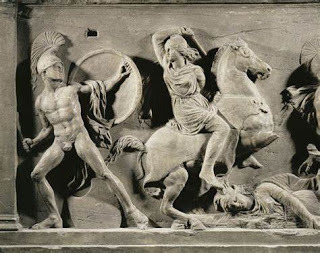
Yesterday I gave my talk on "Women at War" for a Women's Institute Group. I always enjoy this talk as it breaks through so many stereotypes - about women, warfare, Greeks, South America, the Royal Navy and more. The official blurb from my website says:In this talk, Rupert Matthews looks at the ways women have been involved in warfare from ancient times to the present day. Starting with the mythical Amazons, and the truth that lies behind the legend, Rupert looks at some of the great women warriors of history such as Boadicea, Zenobia of Palmyra, Artemisia of Caria, Mavia the Arab, Lagertha the Viking, Tomoe Gozen the Samurai, Joan of Arc, Mary Ralphson, Joanna Salter and Mary Dixon before looking at the mass participation of women in 20th century warfare through the WRNS, WAAFs and ATS of World War II. The talk kicks off with the Amazons, the famous tribe of women warriors that feature so strongly in Greek Legend. The audience loved how I explained the way that the apparently nonsensical Greek myths and fables about these women warriors were actually based on real fact. And how the archaeologists had been digging up burials of these ancient women warriors for most of the 20th century without realising whatthey had found. The archaeologists found bodies with weaponry and so just assumed that the bodies were those of men. It wasn't until one scientist spotted that the body he was studying was female that the truth was uncovered. And I later explain why the Amazon River is called the "Amazon" by unveiling yet another unexpected myth-buster. But I think the bit the audience liked best was the section on Aethelflaed of Mercia who fought against the Vikings in the early 10th century. Again, some lovely stereotypes demolisehd as the brutal warfare of the period was revealed to have been as much about tactical innovation as about bashing each other as axes. If you fancy having this talk - or one of my others - for your group either via Zoom in the near future or in person once restrictions are lifted, get in touch on rupert@rupertmatthews.com or visit my website.

January 12, 2021
BOOK REVIEW - Rebel by Douglas Carswell
 Douglas Carswell has an axe to grind - which makes this book far more enjoyable and interesting than most of the political books that I plough my way through. I flew through the well-written pages ennjoying every single insult, gibe and sarcastic thrust that Carswell hurled at those he blames for the miseries of mankind.
Douglas Carswell has an axe to grind - which makes this book far more enjoyable and interesting than most of the political books that I plough my way through. I flew through the well-written pages ennjoying every single insult, gibe and sarcastic thrust that Carswell hurled at those he blames for the miseries of mankind. Carswell's main point - admirably made with numerous historical exampales - is that the people in power have a tendency to feather their own nests not only at the expense of others, but even if that means ultimately reducing the amount of prosperity in the society they rule and thus making themselves poorer. That tendency can be halted, but only if power is diffused through society so that the elites do not have the power to rush headlong into economic suicide.
He then shows how there are chilling indications that our Western society is starting on the road to disaster.
Well-written, well-argued, well-thought out. Doesn't mean he's correct of course, but make your own mind up.

January 11, 2021
Spellbinding Buttons

Today I kept a U3A group spellbound for well over an hour with my talk on the "History of Buttons".
Today's audience were especially interested in the Pearly Kings and Queens of London's East end.
The practice of wearing clothes decorated with mother of pearl buttons is first associated with Henry Croft (1861-1930), an orphan street sweeper who collected money for charity. At the time, London costermongers (street traders) were in the habit of wearing trousers decorated at the seams with pearl buttons . In the late 1870s, Croft adapted this to create a pearly suit to draw attention to himself and aid his fund-raising activities. In 1911 an organised pearly society was formed in London.
A memorial statue of Henry Croft was donated by the Hospitals, societies, and other charitable organisations Henry had helped in his lifetime. The statue was placed in Finchley Cemetery where Henry was buried, but after it was vandalised was moved to the Crypt of St Martins In The Fields.
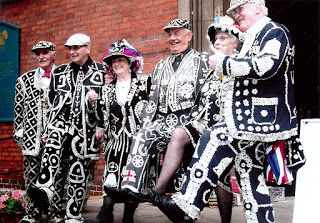
I have a wide variety of talks to give via Zoom - or in real life when restrictions are lifted. Find out moere on my website.




